Hyperaccumulators for Potentially Toxic Elements: A Scientometric Analysis
Abstract
:1. Introduction
2. Materials and Methods
3. Results and Discussion
3.1. Annual Publication Trend
3.2. Citation Network of Authors, Organizations, and Countries
3.3. Most Recognized Journals
3.4. Highly Impacted Studies
3.5. Co-Occurrence Analysis of Keywords
3.6. Keywords with the Strongest Citation Bursts
4. Conclusions and Perspectives
Author Contributions
Funding
Institutional Review Board Statement
Informed Consent Statement
Data Availability Statement
Conflicts of Interest
References
- Govindasamy, C.; Arulpriya, M.; Ruban, P.; Jenifer, L.F.; Ilayaraja, A. Concentration of heavy metals in Seagrasses tissue of the Palk Strait, Bay of Bengal. Int. J. Environ. Sci. 2011, 2, 145–153. [Google Scholar]
- Feinberg, A.; McKelvey, W.; Hore, P.; Kanchi, R.; Parsons, P.J.; Palmer, C.D.; Thorpe, L.E. Declines in adult blood lead levels in New York City compared with the United States, 2004–2014. Environ. Res. 2018, 163, 194–200. [Google Scholar] [CrossRef]
- Gu, Y.; Wang, P.; Zhang, S.; Dai, J.; Chen, H.P.; Lombi, E.; Howard, D.L.; van der Ent, A.; Zhao, F.J.; Kopittke, P.M. Chemical Speciation and Distribution of Cadmium in Rice Grain and Implications for Bioavailability to Humans. Environ. Sci. Technol. 2020, 54, 12072–12080. [Google Scholar] [CrossRef] [PubMed]
- Woldetsadik, D.; Drechsel, P.; Keraita, B.; Itanna, F.; Gebrekidan, H. Heavy metal accumulation and health risk assessment in wastewater-irrigated urban vegetable farming sites of Addis Ababa, Ethiopia. Int. J. Food Contam. 2017, 4, 9. [Google Scholar] [CrossRef]
- Feng, W.; Guo, Z.; Xiao, X.; Peng, C.; Shi, L.; Ran, H.; Xu, W. Atmospheric deposition as a source of cadmium and lead to soil-rice system and associated risk assessment. Ecotoxicol. Environ. Saf. 2019, 180, 160–167. [Google Scholar] [CrossRef]
- Shotyk, W.; Weiss, D.; Appleby, P.; Cheburkin, A.; Frei, R.; Gloor, M.; Kramers, J.D.; Reese, S.; Van Der Knaap, W.O. History of atmospheric lead deposition since 12,370 14C yr BP from a peat bog, Jura Mountains, Switzerland. Science 1998, 281, 1635–1640. [Google Scholar] [CrossRef] [PubMed] [Green Version]
- Abdelwaheb, M.; Jebali, K.; Dhaouadi, H.; Dridi-Dhaouadi, S. Adsorption of nitrate, phosphate, nickel and lead on soils: Risk of groundwater contamination. Ecotoxicol. Environ. Saf. 2019, 179, 182–187. [Google Scholar] [CrossRef]
- Ali, H.; Khan, E.; Sajad, M.A. Phytoremediation of heavy metals-Concepts and applications. Chemosphere 2013, 91, 869–881. [Google Scholar] [CrossRef] [PubMed]
- Adamidis, G.C.; Aloupi, M.; Mastoras, P.; Papadaki, M.I.; Dimitrakopoulos, P.G. Is annual or perennial harvesting more efficient in Ni phytoextraction? Plant Soil 2017, 418, 205–218. [Google Scholar] [CrossRef]
- Xiao, R.; Ali, A.; Wang, P.; Li, R.; Tian, X.; Zhang, Z. Comparison of the feasibility of different washing solutions for combined soil washing and phytoremediation for the detoxification of cadmium (Cd) and zinc (Zn) in contaminated soil. Chemosphere 2019, 230, 510–518. [Google Scholar] [CrossRef] [PubMed]
- Zloch, M.; Kowalkowski, T.; Tyburski, J.; Hrynkiewicz, K. Modeling of phytoextraction efficiency of microbially stimulated Salix dasyclados L. in the soils with different speciation of heavy metals. Int. J. Phytoremediat. 2017, 19, 1150–1164. [Google Scholar] [CrossRef]
- Kukier, U.; Peters, C.A.; Chaney, R.L.; Angle, J.S.; Roseberg, R.J. The effect of pH on metal accumulation in two Alyssum species. J. Environ. Qual. 2004, 33, 2090–2102. [Google Scholar] [CrossRef] [PubMed]
- Macnair, M.R. The Hyperaccumulation of Metals by Plants. In Advances in Botanical Research; Callow, J.A., Ed.; Elsevier: Amsterdam, The Netherlands, 2003; Volume 40, pp. 63–105. [Google Scholar]
- Assuncao, A.G.L.; Schat, H.; Aarts, M.G.M. Thlaspi caerulescens, an attractive model species to study heavy metal hyperaccumulation in plants. New Phytol. 2003, 159, 351–360. [Google Scholar] [CrossRef] [PubMed]
- Luo, J.P.; Tao, Q.; Jupa, R.; Liu, Y.K.; Wu, K.R.; Song, Y.C.; Li, J.X.; Huang, Y.; Zou, L.Y.; Liang, Y.C.; et al. Role of Vertical Transmission of Shoot Endophytes in Root-Associated Microbiome Assembly and Heavy Metal Hyperaccumulation in Sedum alfredii. Environ. Sci. Technol. 2019, 53, 6954–6963. [Google Scholar] [CrossRef]
- Rascio, N.; Navari-Izzo, F. Heavy metal hyperaccumulating plants: How and why do they do it? And what makes them so interesting? Plant Sci. 2011, 180, 169–181. [Google Scholar] [CrossRef]
- Schat, H.; Llugany, M.; Vooijs, R.; Hartley-Whitaker, J.; Bleeker, P.M. The role of phytochelatins in constitutive and adaptive heavy metal tolerances in hyperaccumulator and non-hyperaccumulator metallophytes. J. Exp. Bot. 2002, 53, 2381–2392. [Google Scholar] [CrossRef] [PubMed] [Green Version]
- Sheoran, V.; Sheoran, A.S.; Poonia, P. Role of Hyperaccumulators in Phytoextraction of Metals from Contaminated Mining Sites: A Review. Crit. Rev. Environ. Sci. Technol. 2011, 41, 168–214. [Google Scholar] [CrossRef]
- Yang, X.; Feng, Y.; He, Z.L.; Stoffella, P.J. Molecular mechanisms of heavy metal hyperaccumulation and phytoremediation. J. Trace Elem. Med. Biol. 2005, 18, 339–353. [Google Scholar] [CrossRef] [PubMed]
- Sun, R.-L.; Zhou, Q.-X. Heavy metal tolerance and hyperaccumulation of higher plants and their molecular mechanisms: A review. Zhiwu Shengtai Xuebao 2005, 29, 497–504. [Google Scholar]
- Afshan, S.; Ali, S.; Bharwana, S.A.; Rizwan, M.; Farid, M.; Abbas, F.; Ibrahim, M.; Mehmood, M.A.; Abbasi, G.H. Citric acid enhances the phytoextraction of chromium, plant growth, and photosynthesis by alleviating the oxidative damages in Brassica napus L. Environ. Sci. Pollut. Res. 2015, 22, 11679–11689. [Google Scholar] [CrossRef]
- Agrawal, B.; Czymmek, K.J.; Sparks, D.L.; Bais, H.P. Transient Influx of Nickel in Root Mitochondria Modulates Organic Acid and Reactive Oxygen Species Production in Nickel Hyperaccumulator Alyssum murale. J. Biol. Chem. 2013, 288, 7351–7362. [Google Scholar] [CrossRef] [Green Version]
- Adams, E.; Miyazaki, T.; Hayaishi-Satoh, A.; Han, M.; Kusano, M.; Khandelia, H.; Saito, K.; Shin, R. A novel role for methyl cysteinate, a cysteine derivative, in cesium accumulation in Arabidopsis thaliana. Sci. Rep. 2017, 7, 182–190. [Google Scholar] [CrossRef] [Green Version]
- Dai, J.L.; Balish, R.; Meagher, R.B.; Merkle, S.A. Development of transgenic hybrid sweetgum (Liquidambar styraciflua x L-formosana) expressing gamma-glutamylcysteine synthetase or mercuric reductase for phytoremediation of mercury pollution. New For. 2009, 38, 35–52. [Google Scholar] [CrossRef]
- Orcen, N. Determination of Cytoplasmic Inheritance Role in Heavy Metal Hyperaccumulation Mechanism of Tobacco Plant. Fresenius Environ. Bull. 2020, 29, 700–705. [Google Scholar]
- Ben Massoud, M.; Sakouhi, L.; Chaoui, A. Effect of plant growth regulators, calcium and citric acid on copper toxicity in pea seedlings. J. Plant Nutr. 2019, 42, 1230–1242. [Google Scholar] [CrossRef]
- Amari, T.; Lutts, S.; Taamali, M.; Lucchini, G.; Sacchi, G.A.; Abdelly, C.; Ghnaya, T. Implication of citrate, malate and histidine in the accumulation and transport of nickel in Mesembryanthemum crystallinum and Brassica juncea. Ecotoxicol. Environ. Saf. 2016, 126, 122–128. [Google Scholar] [CrossRef]
- Ingle, R.A.; Mugford, S.T.; Rees, J.D.; Campbell, M.M.; Smith, J.A.C. Constitutively high expression of the histidine biosynthetic pathway contributes to nickel tolerance in hyperaccumulator plants. Plant Cell 2005, 17, 2089–2106. [Google Scholar] [CrossRef] [Green Version]
- Zemanova, V.; Pavlik, M.; Pavlikova, D.; Tlustos, P. The significance of methionine, histidine and tryptophan in plant responses and adaptation to cadmium stress. Plant Soil Environ. 2014, 60, 426–432. [Google Scholar] [CrossRef]
- Wycisk, K.; Kim, E.J.; Schroeder, J.I.; Kramer, U. Enhancing the first enzymatic step in the histidine biosynthesis pathway increases the free histidine pool and nickel tolerance in Arabidopsis thaliana. FEBS Lett. 2004, 578, 128–134. [Google Scholar] [CrossRef]
- Callahan, D.L.; Baker, A.J.M.; Kolev, S.D.; Wedd, A.G. Metal ion ligands in hyperaccumulating plants. J. Biol. Inorg. Chem. 2006, 11, 2–12. [Google Scholar] [CrossRef]
- Lei, M.; Wan, X.M.; Huang, Z.C.; Chen, T.B.; Li, X.W.; Liu, Y.R. First evidence on different transportation modes of arsenic and phosphorus in arsenic hyperaccumulator Pteris vittata. Environ. Pollut. 2012, 161, 1–7. [Google Scholar] [CrossRef]
- Tu, C.; Ma, L.Q. Effects of arsenate and phosphate on their accumulation by an arsenic-hyperaccumulator Pteris vittata L. Plant Soil 2003, 249, 373–382. [Google Scholar] [CrossRef]
- Asemaneh, T.; Ghaderian, S.M.; Crawford, S.A.; Marshall, A.T.; Baker, A.J.M. Cellular and subeellular compartmentation of Ni in the Eurasian serpentine plants Alyssum bracteatum, Alyssum murale (Brassicaceae) and Cleome heratensis (Capparaceae). Planta 2006, 225, 193–202. [Google Scholar] [CrossRef] [PubMed]
- Yang, X.; Li, T.Q.; Yang, J.C.; He, Z.L.; Lu, L.L.; Meng, F.H. Zinc compartmentation in root, transport into xylem, and absorption into leaf cells in the hyperaccumulating species of Sedum alfredii Hance. Planta 2006, 224, 185–195. [Google Scholar] [CrossRef] [PubMed]
- Miransari, M. Hyperaccumulators, arbuscular mycorrhizal fungi and stress of heavy metals. Biotechnol. Adv. 2011, 29, 645–653. [Google Scholar] [CrossRef]
- Clemens, S. Developing tools for phytoremediation: Towards a molecular understanding of plant metal tolerance and accumulation. Int. J. Occup. Med. Environ. Health 2001, 14, 235–239. [Google Scholar] [PubMed]
- Alcantara-Martinez, N.; Guizar, S.; Rivera-Cabrera, F.; Anicacio-Acevedo, B.E.; Buendia-Gonzalez, L.; Volke-Sepulveda, T. Tolerance, arsenic uptake, and oxidative stress in Acacia farnesiana under arsenate-stress. Int. J. Phytoremediat. 2016, 18, 671–678. [Google Scholar] [CrossRef] [PubMed]
- Chen, H.; Cutright, T.J. The interactive effects of chelator, fertilizer, and rhizobacteria for enhancing phytoremediation of heavy metal contaminated soil. J. Soils Sediments 2002, 2, 203–210. [Google Scholar] [CrossRef]
- Ent, A.; Baker, A.J.M.; Reeves, R.D.; Pollard, A.J.; Schat, H. Hyperaccumulators of metal and metalloid trace elements: Facts and fiction. Plant Soil 2013, 362, 319–334. [Google Scholar]
- Kirkham, M.B. Cadmium in plants on polluted soils: Effects of soil factors, hyperaccumulation, and amendments. Geoderma 2006, 137, 19–32. [Google Scholar] [CrossRef]
- Han, R.; Zhou, B.; Huang, Y.; Lu, X.; Li, S.; Li, N. Bibliometric overview of research trends on heavy metal health risks and impacts in 1989–2018. J. Clean. Prod. 2020, 276, 123249. [Google Scholar] [CrossRef]
- Zhao, Q.L.; Wen-Ru, L.U. Research Review and Prospect of Soil Heavy Metals Pollution—Bibliometric Analysis Based on Web of Science. Environ. Sci. Technol. 2010, 33, 105–111. [Google Scholar]
- Ngah, W.; Teong, L.C.; Hanafiah, M. Adsorption of dyes and heavy metal ions by chitosan composites: A review. Carbohydr. Polym. 2011, 83, 1446–1456. [Google Scholar] [CrossRef]
- Lars, J. Hazards of heavy metal contamination. Br. Med. Bull. 2003, 68, 167–182. [Google Scholar]
- Eck, N.J.; Waltman, L. Software survey: VOSviewer, a computer program for bibliometric mapping. Scientometrics 2010, 84, 523–538. [Google Scholar] [PubMed] [Green Version]
- Garfield, E. From the science of science to Scientometrics visualizing the history of science with HistCite software. J. Informetr. 2009, 3, 173–179. [Google Scholar] [CrossRef] [Green Version]
- Chen, C.M. CiteSpace II: Detecting and visualizing emerging trends and transient patterns in scientific literature. J. Am. Soc. Inf. Sci. Technol. 2006, 57, 359–377. [Google Scholar] [CrossRef] [Green Version]
- Small, H. Co-citation in the scientific literature: A new measure of the relationship between two documents. J. Am. Soc. Inf. Sci. 1973, 24, 265–269. [Google Scholar] [CrossRef]
- Jiang, L.Y.; Yang, X.E.; He, Z.L. Growth response and phytoextraction of copper at different levels in soils by Elsholtzia splendens. Chemosphere 2004, 55, 1179–1187. [Google Scholar] [CrossRef] [PubMed]
- Chao, Y.E.; Zhang, M.; Feng, Y.; Yang, X.E.; Islam, E. cDNA-AFLP analysis of inducible gene expression in zinc hyperaccumulator Sedum alfredii Hance under zinc induction. Environ. Exp. Bot. 2010, 68, 107–112. [Google Scholar] [CrossRef]
- Chao, Y.E.; Zhang, M.; Tian, S.K.; Lu, L.L.; Yang, X.E. Differential generation of hydrogen peroxide upon exposure to zinc and cadmium in the hyperaccumulating plant specie (Sedum alfredii Hance). J. Zhejiang Univ. Sci. B 2008, 9, 243–249. [Google Scholar] [CrossRef] [Green Version]
- Chen, B.; Shen, J.G.; Zhang, X.C.; Pan, F.S.; Yang, X.E.; Feng, Y. The Endophytic Bacterium, Sphingomonas SaMR12, Improves the Potential for Zinc Phytoremediation by Its Host, Sedum alfredii. PLoS ONE 2014, 9, e106826. [Google Scholar] [CrossRef] [PubMed]
- Guo, W.D.; Liang, J.; Yang, X.E.; Chao, Y.E.; Feng, Y. Response of ATP sulfurylase and serine acetyltransferase towards cadmium in hyperaccumulator Sedum alfredii Hance. J. Zhejiang Univ. Sci. B 2009, 10, 251–257. [Google Scholar] [CrossRef] [PubMed] [Green Version]
- Jiang, L.Y.; Yang, X.E.; Shi, W.Y.; Ye, Z.Q.; He, Z.L. Copper uptake and tolerance in two contrasting ecotypes of Elsholtzia argyi. J. Plant Nutr. 2004, 27, 2067–2083. [Google Scholar] [CrossRef]
- Jiang, L.Y.; Yang, X.E.; Ye, Z.Q.; Shi, W.Y. Uptake, distribution and accumulation of copper in two ecotypes of Elsholtzia. Pedosphere 2003, 13, 359–366. [Google Scholar]
- Jin, X.F.; Yang, X.E.; Islam, E.; Liu, D.; Mahmood, Q.; Li, H.; Li, J.Y. Ultrastructural changes, zinc hyperaccumulation and its relation with antioxidants in two ecotypes of Sedum alfredii Hance. Plant Physiol. Biochem. 2008, 46, 997–1006. [Google Scholar] [CrossRef]
- He, B.; Yang, X.E.; Ni, W.Z.; Wei, Y.Z.; Long, X.X.; Ye, Z.Q. Sedum alfredii: A new lead-accumulating ecotype. Acta Bot. Sin. 2002, 44, 1365–1370. [Google Scholar]
- Angle, J.S.; Baker, A.J.M.; Whiting, S.N.; Chaney, R.L. Soil moisture effects on uptake of metals by Thlaspi, Alyssum, and Berkheya. Plant Soil 2003, 256, 325–332. [Google Scholar] [CrossRef]
- Baker, A.J.M.; Reeves, R.D.; Hajar, A.S.M. Heavy-Metal Accumulation and Tolerance in British Populations of the Metallophyte Thlaspi-Caerulescens J-And-C-Presl (Brassicaceae). New Phytol. 1994, 127, 61–68. [Google Scholar] [CrossRef]
- Peterson, L.R.; Trivett, V.; Baker, A.J.M.; Aguiar, C.; Pollard, A.J. Spread of metals through an invertebrate food chain as influenced by a plant that hyperaccumulates nickel. Chemoecology 2003, 13, 103–108. [Google Scholar] [CrossRef]
- Angle, J.S.; Chaney, R.L.; Baker, A.J.M.; Li, Y.; Reeves, R.; Volk, V.; Roseberg, R.; Brewer, E.; Burke, S.; Nelkin, J. Developing commercial phytoextraction technologies: Practical considerations. S. Afr. J. Sci. 2001, 97, 619–623. [Google Scholar]
- Fernando, D.R.; Bakkaus, E.J.; Perrier, N.; Baker, A.J.M.; Woodrow, I.E.; Batianoff, G.N.; Collins, R.N. Manganese accumulation in the leaf mesophyll of four tree species: A PIXE/EDAX localization study. New Phytol. 2006, 171, 751–758. [Google Scholar] [CrossRef] [PubMed]
- Broadley, M.R.; Willey, N.J.; Wilkins, J.C.; Baker, A.J.M.; Mead, A.; White, P.J. Phylogenetic variation in heavy metal accumulation in angiosperms. New Phytol. 2001, 152, 9–27. [Google Scholar] [CrossRef]
- Baker, A.J.M.; McGrath, S.P.; Sidoli, C.M.D.; Reeves, R.D. The Possibility of in-Situ Heavy-Metal Decontamination of Polluted Soils Using Crops of Metal-Accumulating Plants. Resour. Conserv. Recycl. 1994, 11, 41–49. [Google Scholar] [CrossRef]
- Salt, D.E.; Blaylock, M.; Kumar, N.; Dushenkov, V.; Ensley, B.D.; Chet, I.; Raskin, I. Phytoremediation—A Novel Strategy for the Removal of Toxic Metals from the Environment Using Plants. Nat. Biotechnol. 1995, 13, 468–474. [Google Scholar] [CrossRef]
- Kumar, P.; Dushenkov, V.; Motto, H.; Raskin, I. Phytoextraction—The Use of Plants to Remove Heavy-Metals from Soils. Environ. Sci. Technol. 1995, 29, 1232–1238. [Google Scholar] [CrossRef]
- Cunningham, S.D.; Berti, W.R.; Huang, J.W.W. Phytoremediation of Contaminated Soils. Trends Biotechnol. 1995, 13, 393–397. [Google Scholar] [CrossRef]
- Pence, N.S.; Larsen, P.B.; Ebbs, S.D.; Letham, D.L.D.; Lasat, M.M.; Garvin, D.F.; Eide, D.; Kochian, L.V. The molecular physiology of heavy metal transport in the Zn/Cd hyperaccumulator Thlaspi caerulescens. Proc. Natl. Acad. Sci. USA 2000, 97, 4956–4960. [Google Scholar] [CrossRef] [Green Version]
- Clemens, S. Molecular mechanisms of plant metal tolerance and homeostasis. Planta 2001, 212, 475–486. [Google Scholar] [CrossRef]
- Verbruggen, N.; Hermans, C.; Schat, H. Molecular mechanisms of metal hyperaccumulation in plants. New Phytol. 2009, 181, 759–776. [Google Scholar] [CrossRef]
- Gerhardt, K.E.; Huang, X.D.; Glick, B.R.; Greenberg, B.M. Phytoremediation and rhizoremediation of organic soil contaminants: Potential and challenges. Plant Sci. 2009, 176, 20–30. [Google Scholar] [CrossRef]
- Ma, L.Q.; Komar, K.M.; Tu, C.; Zhang, W.H.; Cai, Y.; Kennelley, E.D. A fern that hyperaccumulates arsenic—A hardy, versatile, fast-growing plant helps to remove arsenic from contaminated soils. Nature 2001, 409, 579. [Google Scholar] [CrossRef]
- Yang, X.E.; Long, X.X.; Ye, H.B.; He, Z.L.; Calvert, D.V.; Stoffella, P.J. Cadmium tolerance and hyperaccumulation in a new Zn-hyperaccumulating plant species (Sedum alfredii Hance). Plant Soil 2004, 259, 181–189. [Google Scholar] [CrossRef]
- Kupper, H.; Lombi, E.; Zhao, F.J.; McGrath, S.P. Cellular compartmentation of cadmium and zinc in relation to other elements in the hyperaccumulator Arabidopsis halleri. Planta 2000, 212, 75–84. [Google Scholar] [CrossRef] [Green Version]
- Garbisu, C.; Alkorta, I. Phytoextraction: A cost-effective plant-based technology for the removal of metals from the environment. Bioresour. Technol. 2001, 77, 229–236. [Google Scholar] [CrossRef]
- Begonia, G.B.; Davis, C.D.; Begonia, M.F.T.; Gray, C.N. Growth responses of Indian mustard Brassica juncea (L.) Czern. and its phytoextraction of lead from a contaminated soil. Bull. Environ. Contam. Toxicol. 1998, 61, 38–43. [Google Scholar] [CrossRef]
- Brennan, M.A.; Shelley, M.L. A model of the uptake, translocation, and accumulation of lead (Pb) by maize for the purpose of phytoextraction. Ecol. Eng. 1999, 12, 271–297. [Google Scholar] [CrossRef]
- Schwartz, C.; Guimont, S.; Saison, C.; Perronnet, K.; Morel, J.L. Phytoextraction of Cd and Zn by the hyperaccumulator plant Thlaspi caerulescens as affected by plant size and origin. S. Afr. J. Sci. 2001, 97, 561–564. [Google Scholar]
- Kramer, U.; CotterHowells, J.D.; Charnock, J.M.; Baker, A.J.M.; Smith, J.A.C. Free histidine as a metal chelator in plants that accumulate nickel. Nature 1996, 379, 635–638. [Google Scholar] [CrossRef]
- Huang, J.W.W.; Chen, J.J.; Berti, W.R.; Cunningham, S.D. Phytoremediation of lead-contaminated soils: Role of synthetic chelates in lead phytoextraction. Environ. Sci. Technol. 1997, 31, 800–805. [Google Scholar] [CrossRef]
- Blaylock, M.J.; Salt, D.E.; Dushenkov, S.; Zakharova, O.; Gussman, C.; Kapulnik, Y.; Ensley, B.D.; Raskin, I. Enhanced accumulation of Pb in Indian mustard by soil-applied chelating agents. Environ. Sci. Technol. 1997, 31, 860–865. [Google Scholar] [CrossRef]
- Raskin, I.; Smith, R.D.; Salt, D.E. Phytoremediation of metals: Using plants to remove pollutants from the environment. Curr. Opin. Biotechnol. 1997, 8, 221–226. [Google Scholar] [CrossRef]
- Chaney, R.L.; Malik, M.; Li, Y.M.; Brown, S.L.; Brewer, E.P.; Angle, J.S.; Baker, A.J.M. Phytoremediation of soil metals. Curr. Opin. Biotechnol. 1997, 8, 279–284. [Google Scholar] [CrossRef]
- Salt, D.E.; Smith, R.D.; Raskin, I. Phytoremediation. Annu. Rev. Plant Physiol. Plant Mol. Biol. 1998, 49, 643–668. [Google Scholar] [CrossRef]
- Lombi, E.; Zhao, F.J.; Dunham, S.J.; McGrath, S.P. Phytoremediation of heavy metal-contaminated soils: Natural hyperaccumulation versus chemically enhanced phytoextraction. J. Environ. Qual. 2001, 30, 1919–1926. [Google Scholar] [CrossRef] [PubMed]
- Fuhrmann, M.; Lasat, M.M.; Ebbs, S.D.; Kochian, L.V.; Cornish, J. Uptake of cesium-137 and strontium-90 from contaminated soil by three plant species; application to phytoremediation. J. Environ. Qual. 2002, 31, 904–909. [Google Scholar] [CrossRef]
- McGrath, S.P.; Zhao, F.J. Phytoextraction of metals and metalloids from contaminated soils. Curr. Opin. Biotechnol. 2003, 14, 277–282. [Google Scholar] [CrossRef]
- Pulford, I.D.; Watson, C. Phytoremediation of heavy metal-contaminated land by trees—A review. Environ. Int. 2003, 29, 529–540. [Google Scholar] [CrossRef]
- Luo, C.L.; Shen, Z.G.; Li, X.D. Enhanced phytoextraction of Cu, Pb, Zn and Cd with EDTA and EDDS. Chemosphere 2005, 59, 1–11. [Google Scholar] [CrossRef] [PubMed] [Green Version]
- Yoon, J.; Cao, X.D.; Zhou, Q.X.; Ma, L.Q. Accumulation of Pb, Cu, and Zn in native plants growing on a contaminated Florida site. Sci. Total Environ. 2006, 368, 456–464. [Google Scholar] [CrossRef]
- Clemens, S. Toxic metal accumulation, responses to exposure and mechanisms of tolerance in plants. Biochimie 2006, 88, 1707–1719. [Google Scholar] [CrossRef] [PubMed]
- Vangronsveld, J.; Herzig, R.; Weyens, N.; Boulet, J.; Adriaensen, K.; Ruttens, A.; Thewys, T.; Vassilev, A.; Meers, E.; Nehnevajova, E.; et al. Phytoremediation of contaminated soils and groundwater: Lessons from the field. Environ. Sci. Pollut. Res. 2009, 16, 765–794. [Google Scholar] [CrossRef]
- Kramer, U. Metal Hyperaccumulation in Plants. In Annual Review of Plant Biology; Merchant, S., Briggs, W.R., Ort, D., Eds.; Annual Reviews: Palo Alto, CA, USA, 2010; Volume 61, pp. 517–534. [Google Scholar]
- Adamidis, G.C.; Aloupi, M.; Kazakou, E.; Dimitrakopoulos, P.G. Intra-specific variation in Ni tolerance, accumulation and translocation patterns in the Ni-hyperaccumulator Alyssum lesbiacum. Chemosphere 2014, 95, 496–502. [Google Scholar] [CrossRef] [PubMed]
- Isaure, M.P.; Huguet, S.; Meyer, C.L.; Castillo-Michel, H.; Testemale, D.; Vantelon, D.; Saumitou-Laprade, P.; Verbruggen, N.; Sarret, G. Evidence of various mechanisms of Cd sequestration in the hyperaccumulator Arabidopsis halleri, the non-accumulator Arabidopsis lyrata, and their progenies by combined synchrotron-based techniques. J. Exp. Bot. 2015, 66, 3201–3214. [Google Scholar] [CrossRef]
- An, Z.Z.; Huang, Z.C.; Lei, M.; Liao, X.Y.; Zheng, Y.M.; Chen, T.B. Zinc tolerance and accumulation in Pteris vittata L. and its potential for phytoremediation of Zn- and As-contaminated soil. Chemosphere 2006, 62, 796–802. [Google Scholar] [CrossRef]
- Sarret, G.; Saumitou-Laprade, P.; Bert, V.; Proux, O.; Hazemann, J.L.; Traverse, A.S.; Marcus, M.A.; Manceau, A. Forms of zinc accumulated in the hyperaccumulator Arabidopsis halleri. Plant Physiol. 2002, 130, 1815–1826. [Google Scholar] [CrossRef] [PubMed] [Green Version]
- Chen, L.; Luo, S.L.; Li, X.J.; Wan, Y.; Chen, J.L.; Liu, C.B. Interaction of Cd-hyperaccumulator Solanum nigrum L. and functional endophyte Pseudomonas sp Lk9 on soil heavy metals uptake. Soil Biol. Biochem. 2014, 68, 300–308. [Google Scholar] [CrossRef]
- Abdel-Wahab, D.A.; Othman, N.; Hamada, A.M. Effects of copper oxide nanoparticles to Solanum nigrum and its potential for phytoremediation. Plant Cell Tissue Organ Cult. 2019, 137, 525–539. [Google Scholar] [CrossRef]
- Li, Z.; Wu, L.H.; Hu, P.J.; Luo, Y.M.; Christie, P. Copper changes the yield and cadmium/zinc accumulation and cellular distribution in the cadmium/zinc hyperaccumulator Sedum plumbizincicola. J. Hazard. Mater. 2013, 261, 332–341. [Google Scholar] [CrossRef]
- Ghazaryan, K.; Movsesyan, H.; Ghazaryan, N.; Watts, B.A. Copper phytoremediation potential of wild plant species growing in the mine polluted areas of Armenia. Environ. Pollut. 2019, 249, 491–501. [Google Scholar] [CrossRef]
- Freitas, F.; Lunardi, S.; Souza, L.B.; von der Osten, J.S.C.; Arruda, R.; Andrade, R.L.T.; Battirola, L.D. Accumulation of copper by the aquatic macrophyte Salvinia biloba Raddi (Salviniaceae). Braz. J. Biol. 2018, 78, 133–139. [Google Scholar] [CrossRef] [PubMed] [Green Version]
- Wojcik, M.; Vangronsveld, J.; Tukiendorf, A. Cadmium tolerance in Thlaspi caerulescens—I. Growth parameters, metal accumulation and phytochelatin synthesis in response to cadmium. Environ. Exp. Bot. 2005, 53, 151–161. [Google Scholar] [CrossRef]
- Banasova, V.; Horak, O.; Nadubinska, M.; Ciamporova, M.; Lichtscheidl, I. Heavy metal content in Thlaspi caerulescens J. et C. Presl growing on metalliferous and non-metalliferous soils in Central Slovakia. Int. J. Environ. Pollut. 2008, 33, 133–145. [Google Scholar] [CrossRef]
- Famulari, S.; Witz, K. A User-Friendly Phytoremediation Database: Creating the Searchable Database, the Users, and the Broader Implications. Int. J. Phytoremediat. 2015, 17, 737–744. [Google Scholar] [CrossRef]
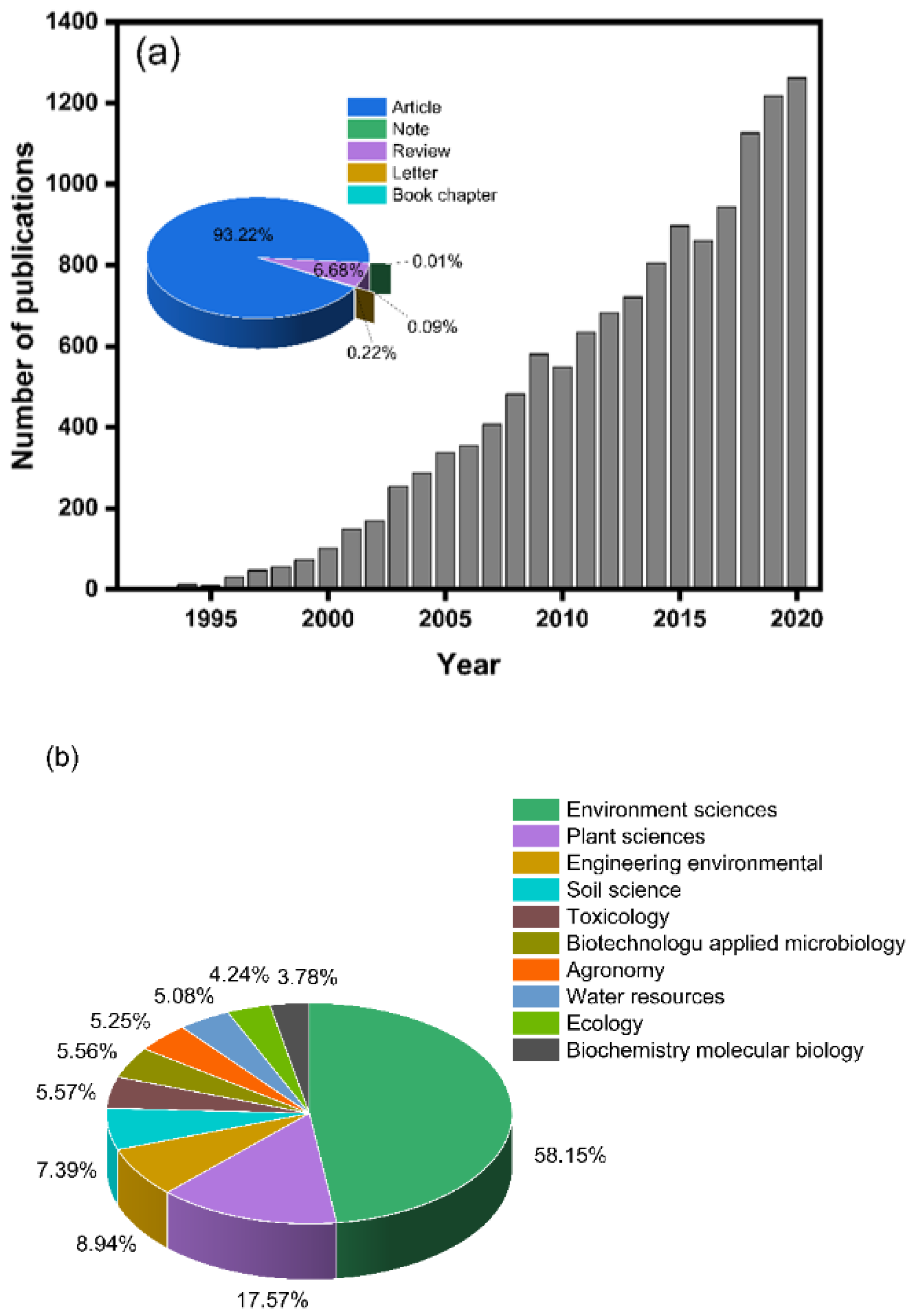
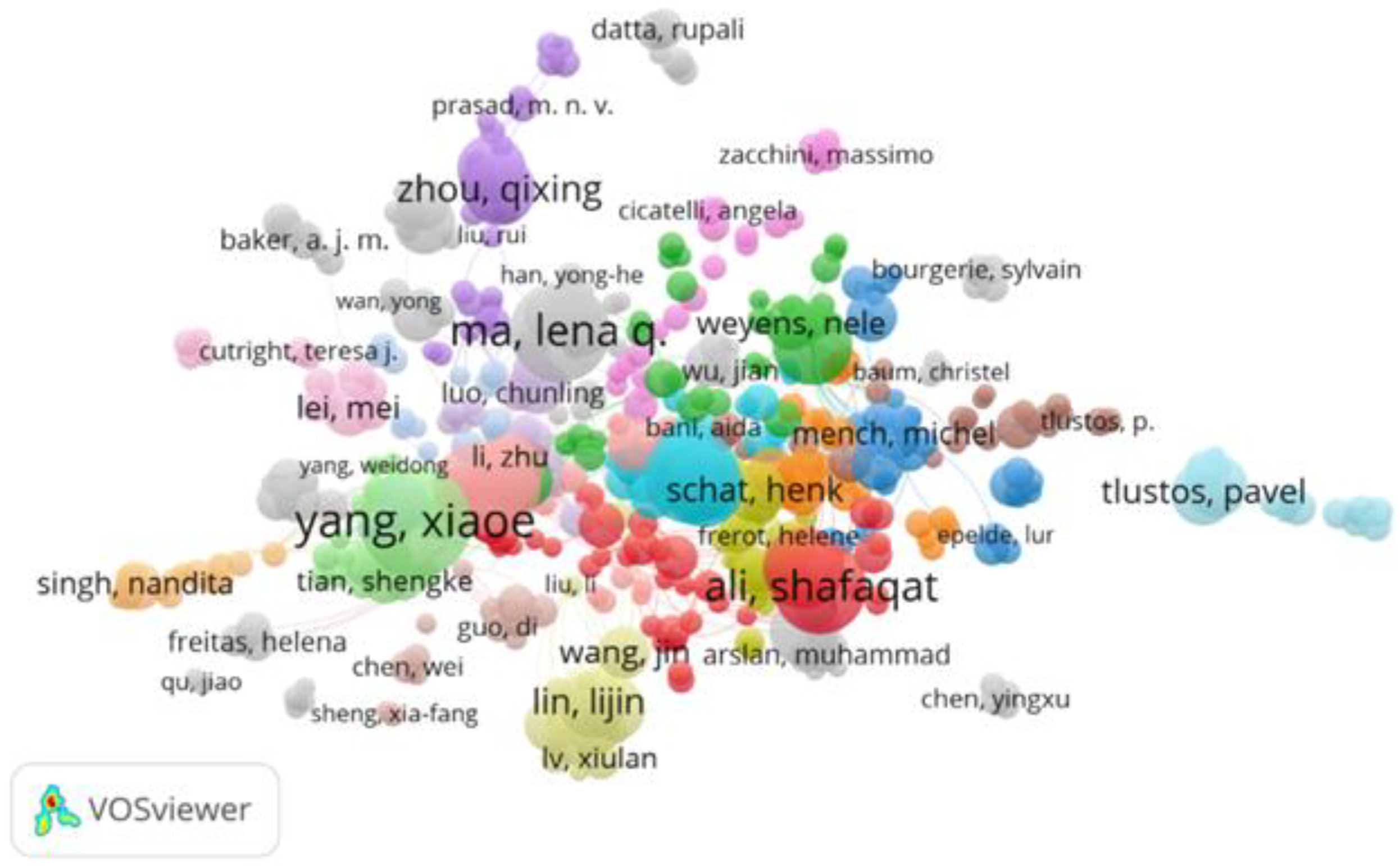

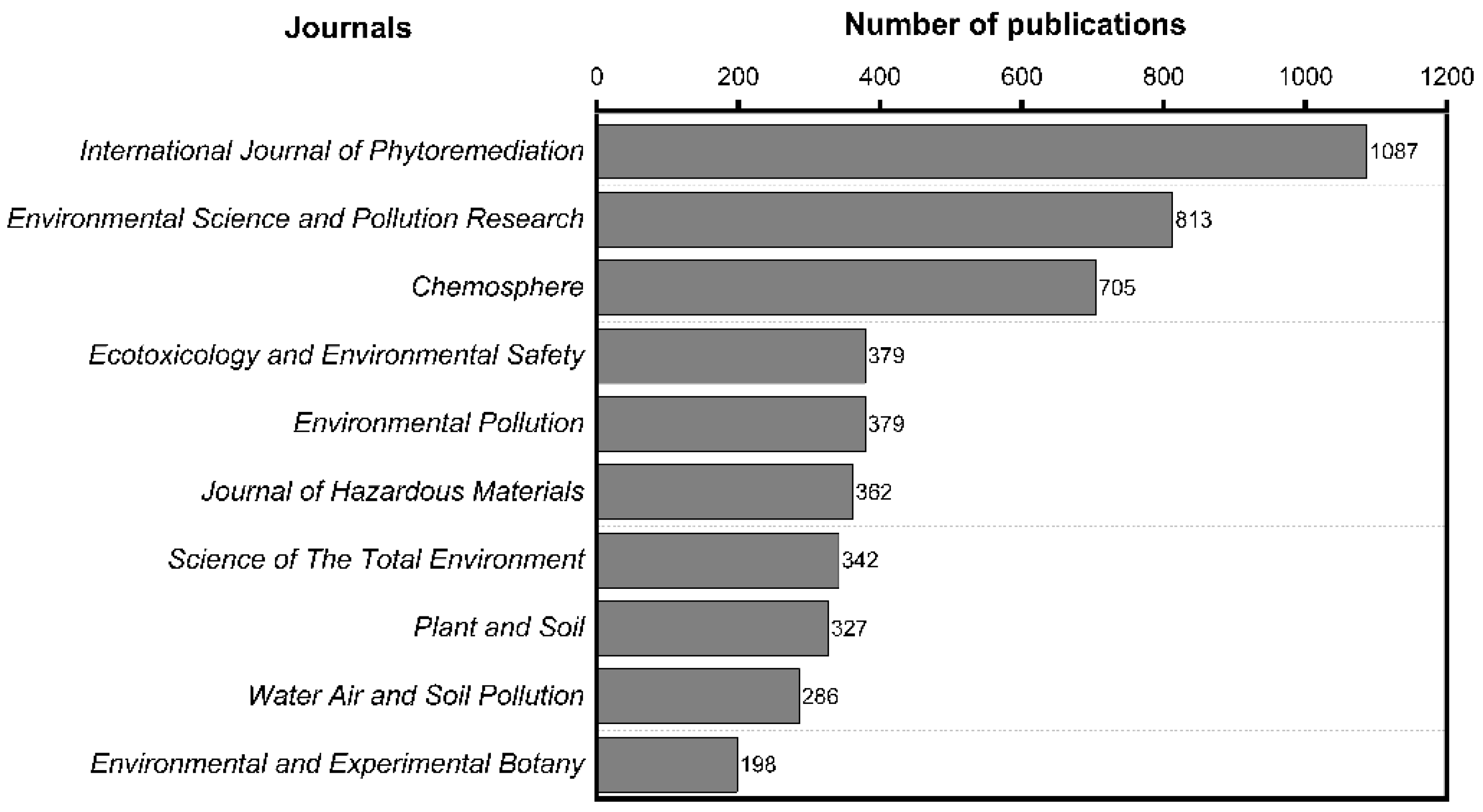
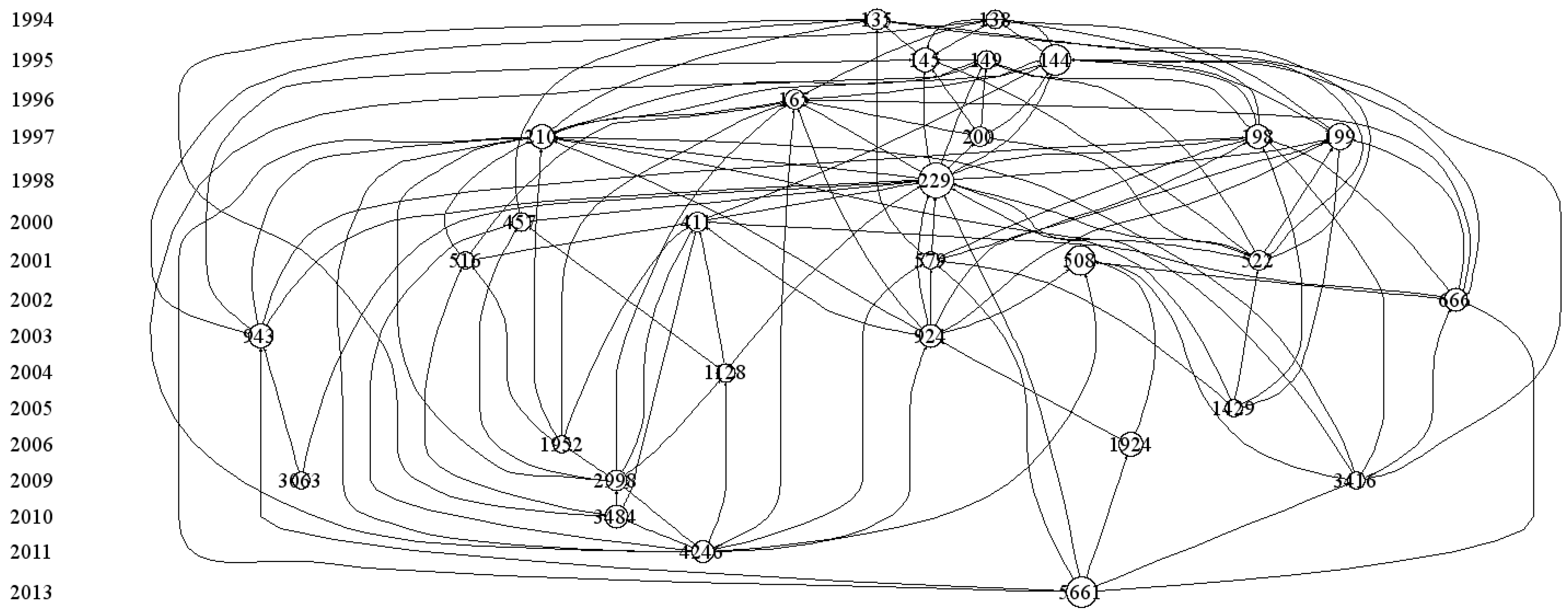

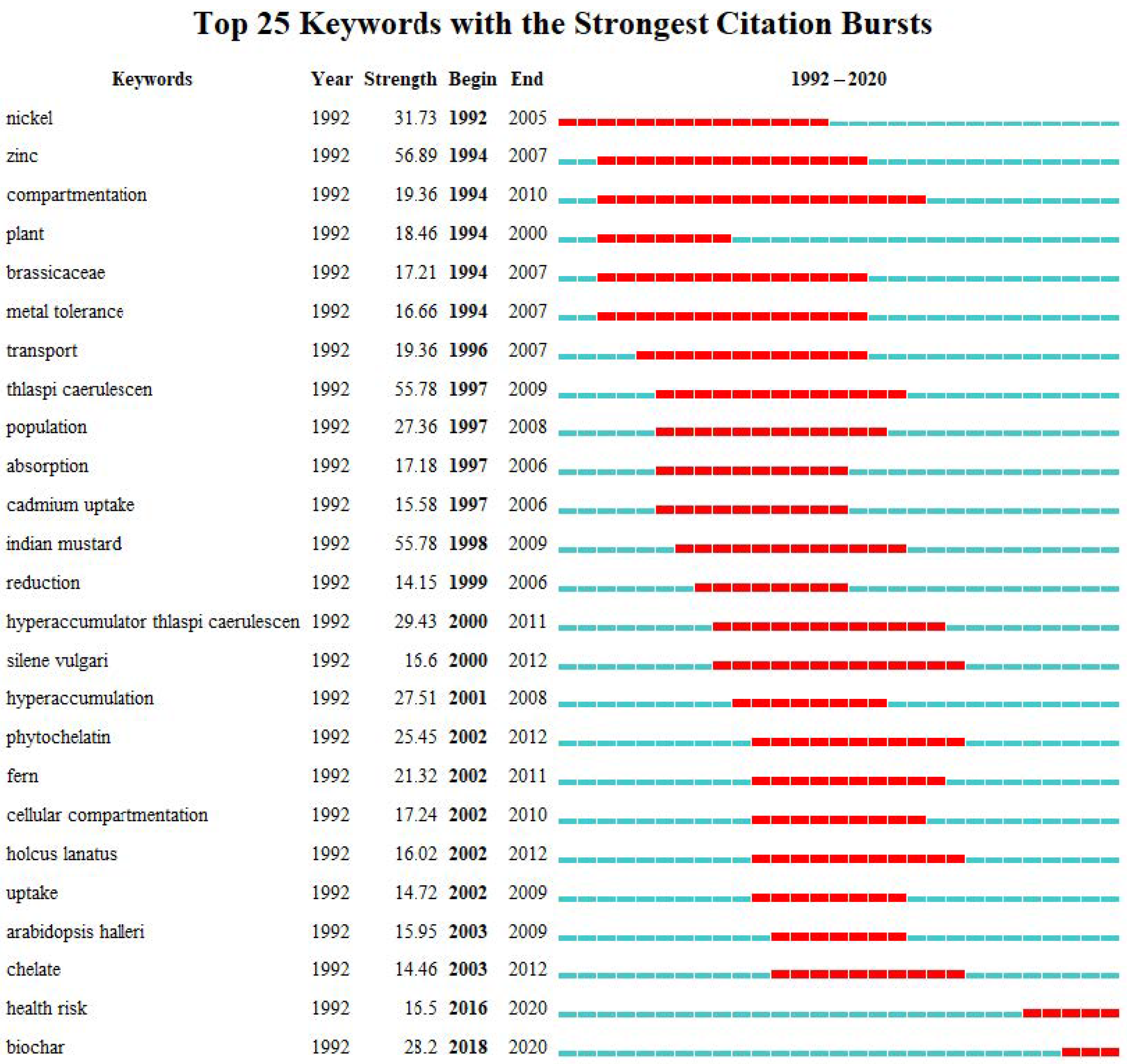
| No. | Items | N | TLCS | TGCS | L | TLS | TGCS/N |
|---|---|---|---|---|---|---|---|
| Top 10 organizations | |||||||
| 1 | Chinese Academy of Sciences (China) | 855 | 10,651 | 24,491 | 182 | 927 | 29 |
| 2 | Zhejiang University (China) | 344 | 5143 | 10,573 | 82 | 274 | 31 |
| 3 | University of Florida (USA) | 226 | 6391 | 12,142 | 69 | 266 | 54 |
| 4 | Nanjing Agricultural University (China) | 207 | 3122 | 6484 | 55 | 180 | 31 |
| 5 | Consejo Superior de Investigaciones Científicas (Spain) | 205 | 1982 | 7769 | 87 | 215 | 38 |
| 6 | University of Chinese Academy of Sciences (China) | 182 | 884 | 2510 | 58 | 278 | 14 |
| 7 | University of Lorraine (France) | 159 | 1039 | 2399 | 69 | 252 | 15 |
| 8 | Sichuan Agricultural University (China) | 147 | 846 | 1823 | 28 | 71 | 12 |
| 9 | The University of Melbourne (Australia) | 141 | 3226 | 6936 | 74 | 209 | 49 |
| 10 | Sun Yat-sen University (China) | 128 | 1655 | 3534 | 52 | 143 | 28 |
| Top 10 countries | |||||||
| 1 | China | 3554 | 32,535 | 79,946 | 61 | 1397 | 22 |
| 2 | USA | 1772 | 37,501 | 90,176 | 65 | 1133 | 51 |
| 3 | India | 1052 | 11,223 | 33,446 | 48 | 384 | 32 |
| 4 | France | 745 | 10,502 | 25,694 | 62 | 789 | 34 |
| 5 | Spain | 694 | 6091 | 20,788 | 53 | 444 | 30 |
| 6 | Italy | 619 | 7379 | 18,489 | 53 | 336 | 30 |
| 7 | Pakistan | 562 | 6212 | 14,449 | 40 | 559 | 26 |
| 8 | Poland | 543 | 2958 | 9168 | 48 | 314 | 17 |
| 9 | Australia | 539 | 7826 | 20,881 | 56 | 617 | 39 |
| 10 | United Kingdom | 539 | 18,318 | 38,660 | 55 | 442 | 72 |
Publisher’s Note: MDPI stays neutral with regard to jurisdictional claims in published maps and institutional affiliations. |
© 2021 by the authors. Licensee MDPI, Basel, Switzerland. This article is an open access article distributed under the terms and conditions of the Creative Commons Attribution (CC BY) license (https://creativecommons.org/licenses/by/4.0/).
Share and Cite
Zhang, D.; Dyck, M.; Filipović, L.; Filipović, V.; Lv, J.; He, H. Hyperaccumulators for Potentially Toxic Elements: A Scientometric Analysis. Agronomy 2021, 11, 1729. https://doi.org/10.3390/agronomy11091729
Zhang D, Dyck M, Filipović L, Filipović V, Lv J, He H. Hyperaccumulators for Potentially Toxic Elements: A Scientometric Analysis. Agronomy. 2021; 11(9):1729. https://doi.org/10.3390/agronomy11091729
Chicago/Turabian StyleZhang, Dongming, Miles Dyck, Lana Filipović, Vilim Filipović, Jialong Lv, and Hailong He. 2021. "Hyperaccumulators for Potentially Toxic Elements: A Scientometric Analysis" Agronomy 11, no. 9: 1729. https://doi.org/10.3390/agronomy11091729
APA StyleZhang, D., Dyck, M., Filipović, L., Filipović, V., Lv, J., & He, H. (2021). Hyperaccumulators for Potentially Toxic Elements: A Scientometric Analysis. Agronomy, 11(9), 1729. https://doi.org/10.3390/agronomy11091729








